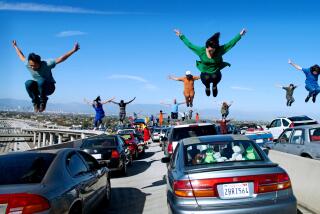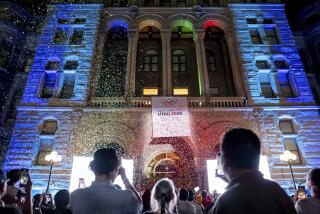Fans Can Get a Ticket to Slide
- Share via
SALT LAKE CITY — Is the Olympic bobsled/luge/skeleton run, adjacent to the Olympic 90K/120K ski-jumping stadiums, obsolete today, the last day of the 2002 Winter Games?
Will some big real estate developer come through here and take what was Utah Olympic Park, attracting about 25,000 people a day for the last 16 days, and make it into Super Large Ski Run and Condo City? Will the residents sit around their fireplaces high up on the mountain 12 years from now and tell their kids that they are sitting on the very spot that Jim Shea started on his gold-medal skeleton run?
Nope.
The Utah Olympic Park will remain just that. It will be a place for U.S. athletes to slide and jump and train and prepare for Winter Games in places not even decided yet. No bulldozers, no cul de sacs, no condos.
Richard Perelman of Los Angeles, the venue chief at Utah Olympic Park, said the mountains where he has spent the last month are part of the Salt Lake Organizing Committee’s legacy to Utah.
“It cost $62.5 million to build,” Perelman said, breaking that down with $33 million for the luge and bobsled runs, $21 million for the ski jump areas, $2.5 million for the lodge and training pool area and $6 million for park infrastructure.
“It was paid for by the state of Utah, then the state was reimbursed by the Salt Lake Committee,” he said.
Such situations are often overlooked in the plus columns when aftermath stories about Olympic host cities are written.
“There should be a steady stream of World Cups here, in both sliding and the ski jumping,” said Perelman, who was the press chief for the 1984 Summer Games in Los Angeles. “In fact, the 2005 World Championships in luge are already set for here. That was the thought right from the start. That was why this was built.”
The only luge and bobsled runs reasonably available before Salt Lake’s for U.S. athlete training were in Lake Placid, N.Y., and Calgary.
“This will be open year-round,” Perelman said, pointing out that the sliding runs are refrigerated and usable during all but the hottest times of the summer, and ski aerialists work hard here all summer on ramps that send them hurtling into a 750,000-gallon swimming pool. The ski jumpers do warm-weather training on plastic runs.
The Joe Quinney Sports Center on the premises, used during the Games for press facilities, will become a winter sports museum.
And, perhaps best of all, people who watched the Games and got hooked on the sliding sports will be able to try them after the Games. There will be a special run, not as long and not as high and not as hard, but a real bobsled run, nevertheless. The cost for a run probably will be around $40, or just slightly more than one of those Olympic berets that are all the rage.
More to Read
Go beyond the scoreboard
Get the latest on L.A.'s teams in the daily Sports Report newsletter.
You may occasionally receive promotional content from the Los Angeles Times.







